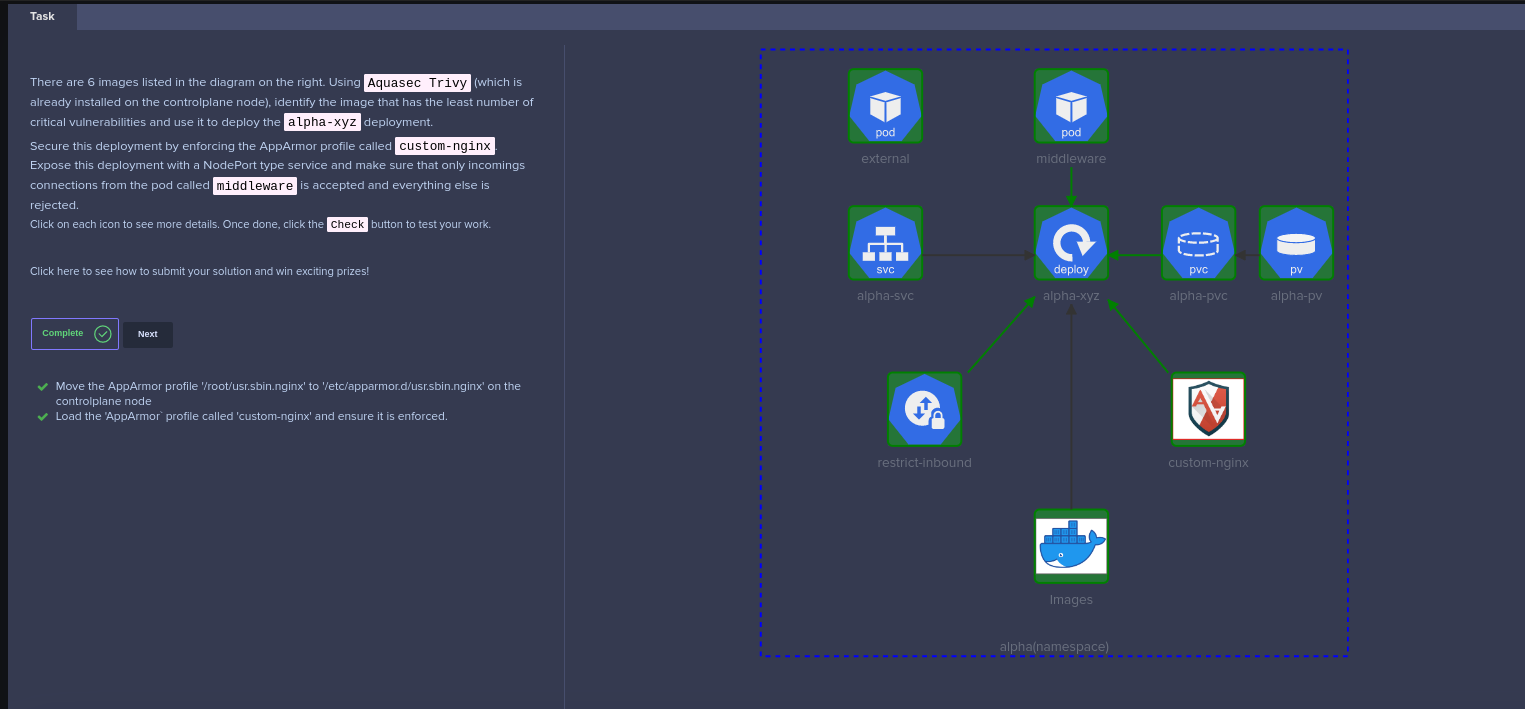KodeKloud CKS Challenge 01

Scanning with Trivy
Trivy uses advanced scanning technology such as vulnerability databases, security advisories, and Common Vulnerability Scoring System (CVSS) to identify potential security vulnerabilities on a range of targets. It is capable of scanning a wide variety of targets, including container images, makes it a versatile and comprehensive security tool.
Here, we shall use a for loop to loop through the list of images, and find the image with least CRITICAL vulnerability.
for image in nginx:alpine bitnami/nginx nginx:1.13 nginx:1.17 nginx:1.16 nginx:1.14
do
trivy image -s CRITICAL ${image}
done
Setting up the AppArmor profile
AppArmor is a Linux security module that restricts an application’s access to resources and actions beyond what is required for normal operation, reducing the attack surface of the application and mitigating potential security risks.
To set the AppArmor profile to be used in the alpha-xyz deployment,
# Inspect the app-armor profile to see if the profile name is correct
cat usr.sbin.nginx
# Then copy it to the default directory
cp usr.sbin.nginx /etc/apparmor.d/usr.sbin.nginx
# set the app-armor profile and verify it is loaded
apparmor_parser /etc/apparmor.d/usr.sbin.nginx
apparmor_status
Troubleshooting the PersistentVolumeClaim (PVC)
Let’s investigate the PersistentVolumeClaim, which have been created.
kubectl get pvc alpha-pvc -o wide
The PVC is not being bounded to the PersistanceVolume (PV), lets investigate further why.
kubectl get pvc alpha-pvc -o yaml
The issue is obvious that the accessModes is not match with the Persistance Volume.
# REDACTED
spec:
accessModes:
- ReadWriteOnce
# REDACTED
Hence, the PVC definition needs to be updated.
# Grab the manifest for PVC
kubectl get pvc alpha-pvc -o yaml > alpha-pvc.yaml
Updated PVC
apiVersion: v1
kind: PersistentVolumeClaim
metadata:
annotations:
kubectl.kubernetes.io/last-applied-configuration: |
{"apiVersion":"v1","kind":"PersistentVolumeClaim","metadata":{"annotations":{},"name":"alpha-pvc","namespace":"alpha"},"spec":{"accessModes":["ReadWriteOnce"],"resources":{"requests":{"storage":"1Gi"}},"storageClassName":"local-storage"}}
creationTimestamp: "2023-05-08T10:43:22Z"
finalizers:
- kubernetes.io/pvc-protection
name: alpha-pvc
namespace: alpha
resourceVersion: "7708"
uid: 296fe5a1-36f5-4c6d-821f-8355d8c1a502
spec:
accessModes:
- ReadWriteMany
resources:
requests:
storage: 1Gi
storageClassName: local-storage
volumeMode: Filesystem
status:
phase: Pending
Then, the PVC should be replaced with the new definition
kubectl replace -f alpha-pvc.yaml --force
# Ensure the PVC is now bounded to the correct PV
kubectl get pvc alpha-pvc -o wide
Deployment alpha-xyz
There are a couple things to be updated here,
- Place the correct image name depending on the trivy scan. In this case
nginx:alpinegot the least number of CRITICAL vulnerabilities - AppArmor profile should be set to
custom-nginxfor nginx container in the Deployment template - The
data-volumeshould be mounted at/usr/share/nginx/html
Following is the completed manifest for the deployment.
apiVersion: apps/v1
kind: Deployment
metadata:
creationTimestamp: null
labels:
app: alpha-xyz
name: alpha-xyz
namespace: alpha
spec:
replicas: 1
selector:
matchLabels:
app: alpha-xyz
strategy: {}
template:
metadata:
creationTimestamp: null
annotations:
container.apparmor.security.beta.kubernetes.io/nginx: localhost/custom-nginx
labels:
app: alpha-xyz
spec:
volumes:
- name: data-volume
persistentVolumeClaim:
claimName: alpha-pvc
containers:
- image: nginx:alpine
name: nginx
volumeMounts:
- mountPath: "/usr/share/nginx/html"
name: data-volume
Then the alpha-xyz can be deployed
kubectl apply -f /root/alpha-xyz.yaml
Services
There are two services to be associated with alpha-xyz deployment
- A NodePort service
- A ClusterIP service (
alpha-svc)
# ClusterIP Service
kubectl expose deployment alpha-xyz --port=80 --target-port=80 --name alpha-svc
# NodePort Service
kubectl expose deployment alpha-xyz --type NodePort --port=80
Network Policies
The network policy is straightforward, only need to consider the ingress traffic to the alpha-xyz deployment
First, get the labels from the middleware pod, so it can be used as in the podSelector.matchLabels
kubectl get pods middleware -o wide --show-labels
Lets create the NetworkPolicy for alpha-xyz deployment
apiVersion: networking.k8s.io/v1
kind: NetworkPolicy
metadata:
name: restrict-inbound
namespace: alpha
spec:
podSelector:
matchLabels:
app: alpha-xyz
policyTypes:
- Ingress
ingress:
- from
- podSelector:
matchLabels:
app: middleware
ports:
- protocol: TCP
port: 80
Once the NetworkPolicy get deployed, to verify the policy
kubectl describe networkpolicies.networking.k8s.io
Smoke testing
The connectivity can be tested
# Should be failed
kubectl exec -it external -- curl alpha-svc
# Should be success
kubectl exec -it middleware -- curl alpha-svc